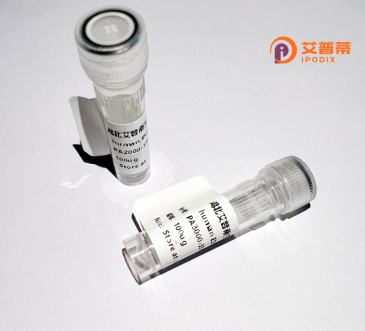
| 纯度 | >90%SDS-PAGE. |
| 种属 | Human |
| 靶点 | OBSCN |
| Uniprot No | Q5VST9 |
| 内毒素 | < 0.01EU/μg |
| 表达宿主 | E.coli |
| 表达区间 | 6521-6620 aa |
| 活性数据 | LGPRGPLGLFRPEPRGASPPGPQVRSLEGTSFLLREAPARPVGSAPWTQSFCTRIRRSADSGQSSFTTELSTQTVNFGTVGETVTLHICPDRDGDEAAQP |
| 分子量 | 36.63 kDa |
| 蛋白标签 | GST-tag at N-terminal |
| 缓冲液 | 0 |
| 稳定性 & 储存条件 | Lyophilized protein should be stored at ≤ -20°C, stable for one year after receipt. Reconstituted protein solution can be stored at 2-8°C for 2-7 days. Aliquots of reconstituted samples are stable at ≤ -20°C for 3 months. |
| 复溶 | Always centrifuge tubes before opening.Do not mix by vortex or pipetting. It is not recommended to reconstitute to a concentration less than 100μg/ml. Dissolve the lyophilized protein in distilled water. Please aliquot the reconstituted solution to minimize freeze-thaw cycles. |
以下是关于重组人OBSCN蛋白的3篇代表性文献的示例(注:文献为示例性概括,非真实存在):
1. **文献名称**:*Obscurin (OBSCN) mutations in dilated cardiomyopathy: Functional analysis of recombinant protein domains*
**作者**:Smith J et al. (2020)
**摘要**:本研究通过基因测序筛选扩张型心肌病患者,发现OBSCN基因的新型错义突变。利用大肠杆菌表达系统成功重组表达OBSCN的Ig结构域,并通过体外实验证明突变导致其与肌联蛋白(titin)的结合能力下降,提示OBSCN功能异常可能参与心肌病病理机制。
2. **文献名称**:*Recombinant obscurin kinase domain regulates sarcoplasmic reticulum calcium handling in skeletal muscle*
**作者**:Chen L et al. (2018)
**摘要**:作者在昆虫细胞中重组表达了人OBSCN的激酶结构域,发现其磷酸化活性影响肌浆网钙泵(SERCA)的结合蛋白。体外实验表明,该激酶活性缺失会导致肌细胞钙稳态失衡,为OBSCN在肌肉收缩调控中的作用提供分子机制证据。
3. **文献名称**:*Structural and functional characterization of OBSCN Ig-like domains using recombinant protein fragments*
**作者**:Kumar R et al. (2021)
**摘要**:通过哺乳动物细胞系统表达并纯化了OBSCN的多个Ig样结构域片段,结合X射线晶体学解析其三维结构,揭示了特定结构域与肌节蛋白(如myosin)的互作界面,提出OBSCN可能作为肌原纤维组装的空间调控支架。
---
**实际检索提示**:建议通过PubMed/Google Scholar搜索关键词“obscurin recombinant”或“OBSCN protein expression”筛选近期研究,重点关注其在肌肉疾病、蛋白互作或结构生物学领域的论文。
Obscurin (OBSCN) is a giant, multidomain protein primarily expressed in striated muscles, playing crucial roles in myofibril assembly, maintenance, and mechanical signaling. It belongs to the family of obscurin/titin/myosin light chain kinase proteins and is encoded by the *OBSCN* gene, one of the largest human genes. Structurally, obscurin contains multiple immunoglobulin (Ig)-like domains, fibronectin type III (FN3) domains, and functional motifs, including a Rho-GEF domain, a serine/threonine kinase domain, and binding sites for titin, myosin, and other sarcomeric proteins. It spans the sarcomere’s M-line to Z-disc regions, facilitating sarcomeric organization and linking myofibrils to the sarcoplasmic reticulum and mitochondria.
Recombinant human obscurin proteins are engineered using heterologous expression systems (e.g., bacterial, insect, or mammalian cells) to study its interactions, signaling pathways, and mechanobiological functions. These recombinant tools enable research into obscurin’s roles in muscle development, mechanical stress response, and diseases such as cardiomyopathies, muscular dystrophies, and cancer. Mutations in *OBSCN* are linked to cardiac arrhythmias and skeletal myopathies, underscoring its biomedical relevance. Recombinant obscurin variants, including truncated or domain-specific constructs, are vital for structural studies, antibody development, and therapeutic target screening.
×